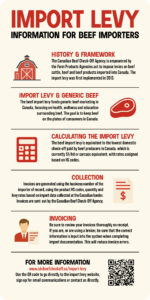Import Levy History & Framework
INFORMATION FOR BEEF IMPORTERS
If you or your company import beef cattle, beef or beef products into Canada, you pay Canada’s beef import levy. The collection of this levy in Canada is an integral part of keeping beef on the plates of consumers in Canada.
- History and Regulatory Framework
- Import Levy and Generic Beef
- Calculation of the Import Levy
- Collection
- Invoicing
- Using a Broker?
HISTORY AND FRAMEWORK
The Canadian Beef Check-Off Agency (the Agency) is the organization mandated to promote the marketing and production of beef cattle, beef and beef products for the purposes of interprovincial, export and import trade. To support its business plan, the Agency is empowered by the federal Farm Products Agencies Act (R.S.C.1985, c. F-4) to impose levies or charges on persons engaged in sale of cattle within Canada, and the importation of beef cattle, beef or beef products into Canada.
Funds collected from the Beef Cattle Research, Market Development and Promotion Levies Order, which includes the import levy, are used to fund research, marketing and promotion of beef cattle, beef, and beef products.
Funds remitted through the import levy are invested in programming focused on increasing the demand for beef in Canada. The programming focuses on the ThinkBeef.ca website, and other health and wellness, culinary and educational programming within the Canadian market, to ensure that beef remains on the plates of Canadian consumers.
The following information has been designed to provide you and your organization with the relevant information you will need to understand the import levy, your rights and obligations, and to help you prepare to remit the fee based on importation data collected through the Canada Border Services Agency (CBSA).
The Agency looks forward to creating a positive working relationship with your organization to the benefit of all stakeholders in the beef industry in Canada.
IMPORT LEVY AND GENERIC BEEF
On June 5, 2013, the Beef Cattle Research, Market Development and Promotion Levies Order (Levies Order) was gazetted and amended to include the import levy which had been mandated as part of the Proclamation in 2002.
The import levy is set up to be equivalent to the domestic check-off on a per head or carcass equivalent basis and can only be invested into generic beef marketing. These activities focus on keeping beef on the plate of Canadian consumers by promoting the healthfulness of beef, growing consumer culinary skills, and reinforcing food safety practices. Generic beef marketing resources and programming can be found online at ThinkBeef.ca.
CALCULATION OF THE IMPORT LEVY
The import levy is set up to be equivalent to the lowest current domestic check-off, which is currently CA$1 per head or carcass equivalent. The Levies Order lays out a formula where each product code (HS code) is assigned a levy value per pound or kilogram.
COLLECTION OF THE IMPORT LEVY
The Agency is the organization responsible for administering the domestic and import levy collection and remittance. To manage the import levy, the Agency works closely with the FPCC and Agriculture and Agri-Food Canada.
Along with Government, the Agency considered several levy collection mechanisms after which it was determined that the most expedient method to collect was to generate invoices based on the information received on all beef, beef cattle and beef products imported into Canada from Agriculture and Agri-Food Canada and Canada Border Services Agency.
The information on the invoices is generated based on the importer’s business identification number; HS codes of imported product; quantity of imported product; and levy rate.
INVOICING
Based on the information received from Canada Border Services Agency, Agriculture and Agri-Food Canada prepares invoices, which are securely delivered to the Agency for distribution and collection. Please note that the schedule is expressed in cents per pound, not dollars per pound, so the listing of .301/lb, is CA $0.00301.
For this system to work efficiently, it is important that all participants in the process pay close attention to the accuracy of their data entry to ensure invoice amounts are correct. All importers should verify the data on the invoice against their own records and report any discrepancies to the Agency.
USING A BROKER? OR ARE YOU A BROKER?
Many importers elect to use a customs broker to manage the paperwork and logistics end of importing products into Canada. Please be sure to work closely with your customs broker and/or your clients to ensure that correct information is input into their systems for submission to CBSA. This includes the “Importer of Record,” and the correct weight in lb/kg.

